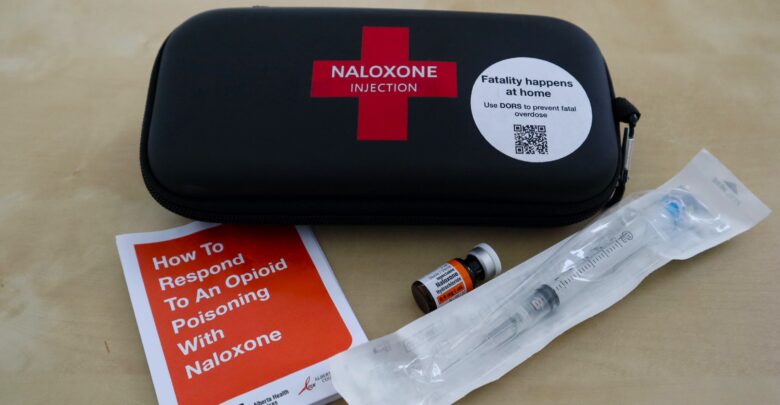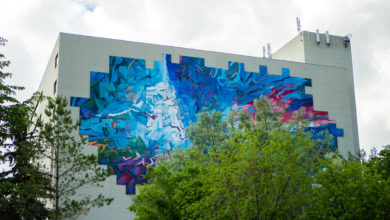Harm reduction on campus: Students pushing for more
The university says it approaches substance use through a harm reduction lens, but some students are asking for more.
 Leah Hennig
Leah HennigIn 2023, Health Canada released data on post-secondary student substance use collected in the 2021–22 Canadian Post-Secondary Education Alcohol and Drug Use Survey (CPADS).
According to that data, 64 per cent of students had consumed alcohol in the past month at the time of the survey. The same survey found 29 per cent of students had used cannabis in the past month. Health Canada also found that 13 per cent of students used a pain reliever, stimulant, sedative, or over-the-counter (OTC) medication in a higher risk way in the past year.
Health Canada defined higher risk as using those substances in a larger dose, more frequently, or for the purpose of getting high. Additionally, 12 per cent of students had used illegal substances in the last year in the same survey.
Among students who had used alcohol in the past year, 47 per cent experienced one of 28 harms from their alcohol consumption. For students who had used cannabis, 64 per cent experienced one of five harms from cannabis use.
With Canada facing a nation-wide overdose crisis, many organizations, such as Health Canada, have emphasized the importance of harm reduction. Harm reduction focuses on reducing negative effects, including overdoses, rather than pushing abstinence. But what place does harm reduction have on the University of Alberta campus?
“We don’t have a great handle on the problem of substance use disorders among students,” Hyshka says
Elaine Hyshka is an associate professor and researcher in the U of A’s School of Public Health. She explained that harm reduction is an approach to risky behaviours, which is not limited to only drug use.
“Essentially, the idea is to support somebody to be as safe and healthy as possible to mitigate some of those risks,” Hyshka said.
When it comes to drug use, harm reduction comes from a place of understanding that such activities are, to some degree, inevitable in society, according to Hyshka.
“We need to focus on finding ways to reduce negative health and social outcomes associated with [substance use],” Hyshka said.
Some aspects of harm reduction focus on education around risks and prevention of overdoses, according to Hyshka. Distributing things like naloxone kits or safe drug consumption supplies can prevent overdoses or reduce risk of bloodborne pathogens.
According to Hyshka, harm reduction is a complementary approach to mitigating risks associated with drug use. It can also be a gateway to treatment for substance use disorder (SUD). According to Hyshka, evidence has shown that harm reduction is associated with an uptake in treatment.
On campus, Hyshka has seen a positive trend towards increased awareness around harm reduction. She has also observed greater attention from university administrators and stakeholders on addressing substance use.
Hyshka said she believes more research still needs to be done on substance use among students.
“We don’t have a great handle on the problem of SUDs among students.”
Hyshka noted the U of A has done surveys in the past about alcohol and drug consumption. However, she still believes post-secondary institutions (PSIs) in general need to do a better job at tracking the health and well-being of their student body.
“We need to teach and give people resources to do drugs as safely as possible,” Bayne says
The Gateway spoke to Hannah Bayne, a graduate student in the School of Public Health. Bayne and Emma Chambers, also a graduate student in the School of Public Health, tabled at the Graduate Students’ Association (GSA) orientation and Week of Welcome (WOW) in fall 2024 to raise awareness about harm reduction.
Their table included pamphlets about harm reduction, as well as harm reduction supplies like naloxone kits and condoms. The Alberta Public Interest Research Group (APIRG) provided funding for the supplies at the table.
Bayne said their goal was to provide student-oriented harm reduction information. “I found generally [harm reduction] focuses on what students can do to support harm reduction as a volunteer, as a researcher, but less on what kind of harm reduction students need,” Bayne said.
According to Bayne, most students are going to use at least one type of substance during their undergraduate career. For many, this is their first time being able to buy and use substances with less barriers, Bayne said. “We need to teach and give people resources to do drugs as safely as possible.”
Bayne noted that WOW has a space dedicated specifically to recreational drug use, referring to WOW Main Stage, informally known as the beer garden.
According to Bayne, student response to the table was overwhelmingly positive. They gave out over 175 naloxone kits in three days.
“I’m really grateful to the U of A community for showing that interest and showing that this is something … students want.”
Table provided “crucial services, support, and information for students that are missing from WOW,” according to Bayne
Bayne and Chambers did experience some barriers to tabling at Clubs Fair. Registered student groups and non-student groups pay different fees to table at WOW Clubs Fair. Because Bayne and Chambers were not a registered student group, they weren’t able to secure a table at the fee for student groups. The GSA and Dean of Students (DoS) office assisted in helping them finally secure a table, Bayne said.
After receiving funding from APIRG, Bayne and Chambers initially reached out to the U of A Students’ Union (UASU) in January to inquire about tabling at Clubs Fair in the fall. According to Bayne, there was a lot of back and forth with the UASU and not very timely communication.
“As the date approached for Club’s Fair, we still had not [found] a way to get our booth in Club’s Fair,” Bayne said. Eventually, Bayne and Chambers were able to secure a table as an external organization at a different fee. The DoS office confirmed it paid that fee for them.
The UASU explained to The Gateway that the usual fee for non-student groups was $1,750 per day. The UASU offered an alternative location in the “university section” of Clubs Fair for a fee of $150 per day. Bayne and Chambers were able to set the table up in that section for two days.
Emails the UASU shared with The Gateway show that Chambers asked for the UASU to waive the fee entirely in January. In an email to Michael Griffiths, the 2023–24 vice-president (student life) of the UASU, Chambers wrote “after attending WOW last year, I was shocked to see the lack of harm reduction supplies and information on campus, particularly during a week where students … [can] legally drink without their parents/guardian during the day at school.” They inquired about the fee being waived “due to the public health application of the [table].”
Griffiths responded in an email to Chambers and said, “I do need to push back against some of your narrative that folks focused on harm reduction are more deserving of a space than other initiatives that take place at WOW.” He explained that the UASU provides equal opportunity for all students interested in tabling at Clubs Fair.
In response, Bayne wrote that they “are actively providing crucial services, support, and information for students that are missing from WOW.” Bayne also explained that while they had received funding from APIRG, they had not budgeted for the tabling fee. This was due to a lack of response from the UASU in their initial inquiry about waiving the fee.
In an interview, Bayne said they wished there had been more flexibility in getting a table at club’s fair. They noted that they understand the UASU itself may deal with levels of bureaucracy, but should still work to address harm reduction on campus. Bayne sees a need for more open collaboration with students across campus who bring a unique perspective or set of skills to a given situation.
“We could really stand to see even more of this [brought] to the forefront of what we’re talking about for concerns of student welfare,” Bayne said.
Harm reduction is about meeting people where they’re at, Arshad explains
The Gateway spoke to Haseeb Arshad, president of the GSA, about its collaboration on the project. The GSA partnered with Bayne and Chambers to provide information about harm reduction at the GSA’s orientation and WOW. He said Tiffany Kang, the previous year’s vice-president (student life), had first started this work. The new executive team continued the work when they began their terms.
Arshad noted that Chambers had been on the GSA’s Equity, Diversity, and Inclusion Committee (EDIC). “They have done substantial work when it comes to harm reduction and outreach initiatives,” Arshad said.
According to Arshad, harm reduction is about meeting people where they are at. He also noted the importance of the safer sex resources the table provided after the disruption of services at the U of A Sexual Assault Centre (UASAC).
Arshad mentioned that the GSA had wanted the project to be a “joint venture” between the GSA and UASU. Part of the reason for that was due to the GSA’s small budget, he said. Collaborating with the UASU would have allowed the initiative to secure a table more easily and at a lesser cost.
Student leaders advocating for the U of A to sign Recovery Friendly Campus Pledge
When asked about future work on harm reduction, Arshad mentioned the Recovery Friendly Campus Pledge, led by Recovery on Campus (ROC). The University of Calgary signed onto ROC’s pledge in September last year.
It includes eight criteria:
- Provide peer-centred, all-recovery pathways programming for students and employees.
- Raise awareness, educate, and advocate about addiction recovery to reduce stigma.
- Ensure that recovery is normalized, valued, and celebrated through increased visibility.
- Provide a recovery-friendly space on campus to build community.
- Create recovery-friendly events and activities on campus.
- Ensure student and employee support teams meet the needs of campus members along the addiction-recovery spectrum.
- Increase awareness and address the needs of family members/friends of campus members in or seeking recovery.
- Promote inclusive campus life by addressing systemic barriers for campus members along the addiction-recovery spectrum.
The GSA has been advocating in collaboration with the UASU for the U of A to sign onto the pledge. Arshad noted that the university has been working to support students, but “there’s not a very co-ordinated effort amongst units.” Arshad said they are still figuring out the framework and financial resources needed if the university does sign on.
The Gateway asked Kevin Friese, assistant dean of students (health, wellness, and student services), about the pledge. Friese mentioned that the university had “pressed pause” on signing the pledge until after the U of A releases its Student Mental Health Action Plan. Friese said he expects to release the plan in the spring.
According to Friese, the pledge fits “with our ideals and principles with regards to approaching substance use.” However, he felt it’s important to have a “solid foundation for identifying how we are going to meet each of the commitments” before signing on.
UASU attempting to decentralize alcohol in student events
Lisa Glock, president of the UASU, said that the Recovery Friendly Campus Pledge is one of the biggest initiatives she’s been working on.
“I want [the university] to have a plan in place and to have a really good outline of how recovery should look on campus going forward,” Glock said.
The Gateway asked how well she thought the university is currently doing in meeting the eight criteria outlined in the pledge. Glock said that’s not data she has, but that she believes “there’s a long way to go for service provision.”
Glock mentioned that the UASU has also been trying to decentralize alcohol from its events in recent years. Renaming the WOW Beer Garden to the WOW Main Stage was part of that effort, according to Glock. She also mentioned providing alcohol-free events, like the UASU’s Awards Gala.
In a statement to The Gateway, the UASU noted that the vice-president (student life), currently Renson Alva, is a member of the university’s Coalition Against High Risk Drinking (CAHRD). The statement said “WOW has never been a concern for this committee as WOW has already implemented harm reduction strategies and provides substance free programming.”
University supports for students with substance use disorders
Friese spoke to The Gateway about the supports the U of A provides for students. According to Friese, the university’s approach to substance use addresses community education, community support, and staff training and support. He said harm reduction is “woven into” the university’s work in supporting students.
Providing “factual information [which] they can use to make informed decisions around substance use” is a key part of community education, he said. The university has an information page about substance awareness. It states that “alcohol and substances are viewed and discussed through a harm reduction lens.”
There is a link to “harm reduction information,” which at the time of the interview led to a “404 page not found.” The page has since been updated. Friese said that staff review and update the information on that website yearly.
According to Friese, the DoS takes a “trauma informed … and evidence informed approach” to supporting students. The DoS often provides student groups with information and training when it’s needed, Friese said.
Additionally, Friese said the university follows the National Standard for Health and Well-Being for Post-Secondary Students. The university considered this when building the framework to support students’ mental health, including students with SUD.
Friese, Chelsea Butler, the U of A’s co-ordinator for the National Standard, and Gurleen Kaur, former UASU vice-president (academic) and an undergraduate intern working with the U of A on the National Standard, presented the National Standard to Students’ Council on February 4.
In the presentation, Butler said that during the student consultation, supports and services for SUD was not mentioned. “We think that speaks to a pretty high level of stigma in this area,” Butler said. Butler also added that “we know that there is a growing and thriving peer support community here on campus for student recovery.”
In The Gateway‘s interview with Friese, he said one community support is the Student Recovery Community, which is a registered student group the UASU supports. Friese said the group tries to “provide a community for students in their journey who are seeking peer-led support.”
According to Friese, the University Health Centre (UHC) Pharmacy provides monthly education sessions on substance use. Through that, staff can connect students with the available supports and resources as well as education, Friese said. The UHC Pharmacy also has naloxone kits available.
Friese described the university’s approach as “looking at the full continuum of where a student may be in their journey and trying to connect them to what’s right in the moment for [them].”
Friese also noted that the U of A Protective Services (UAPS) and residence staff receive integrated training. He said the training includes education around substance use and the delivery of naloxone. With that training, they are able to “understand how to respond in a safe and appropriate way and support individuals in the moment.”
Currently, university supports are available for students dealing with and recovering from SUD. Additionally, students have evidently made efforts to prioritize harm reduction on campus, whether that’s providing naloxone kits at WOW or advocating for the university to sign the Recovery Friendly Campus Pledge. But, these efforts, like the wider push for harm reduction in Canada, are ongoing. As Canadians decide how to address SUD within their communities, U of A students and faculty have to decide how SUD will be addressed on campus.




